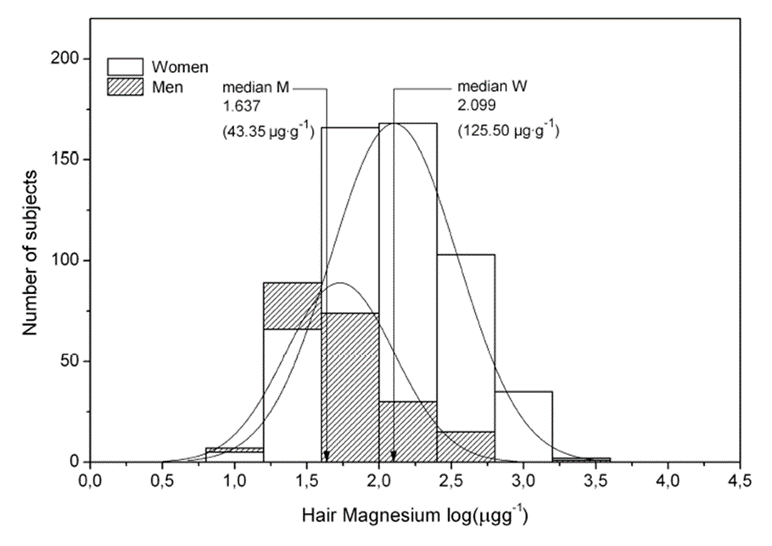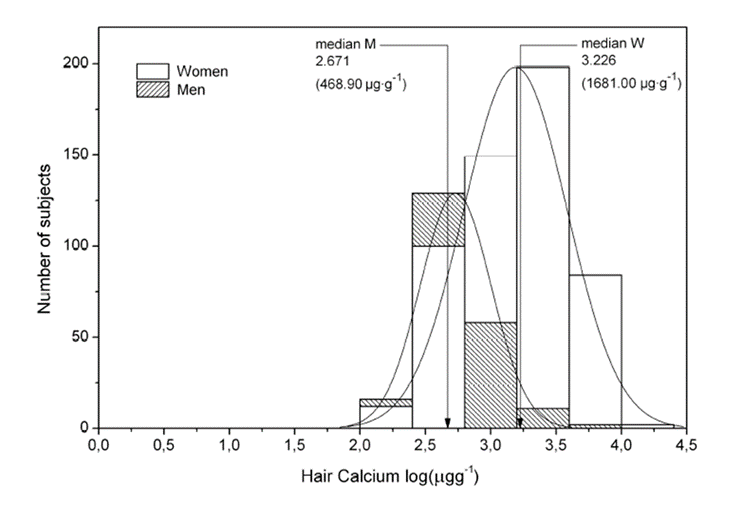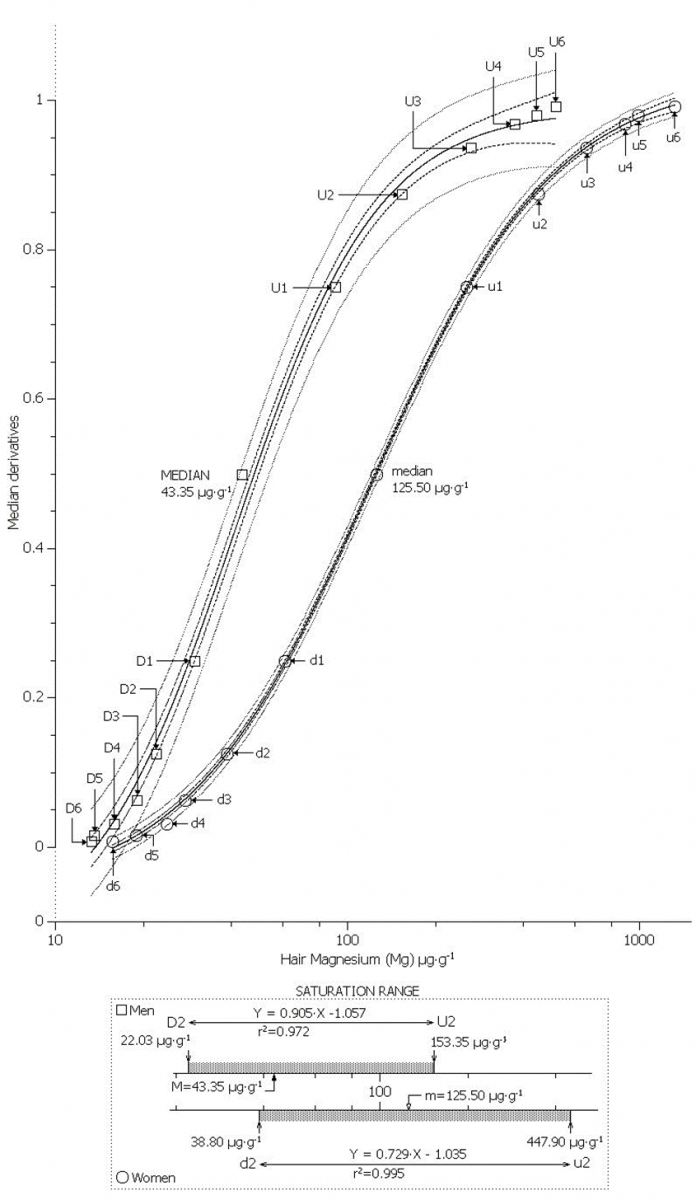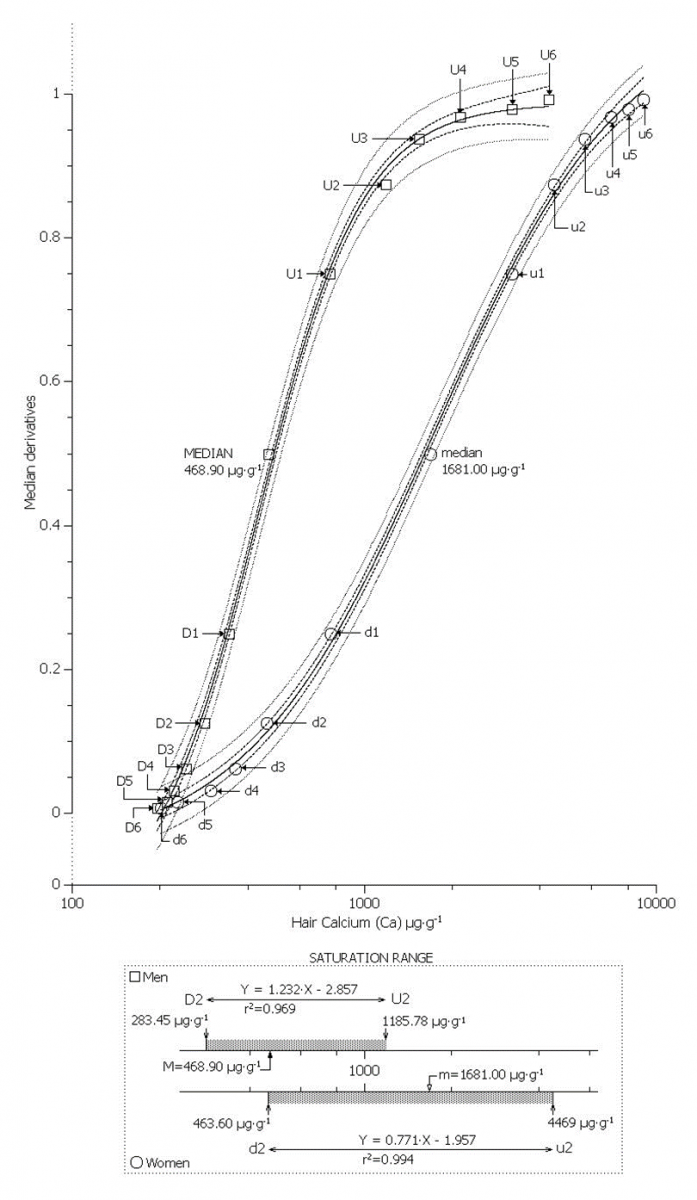Previous Issues Volume 6, Issue 1 - 2023
Sex Does Matter. Assessing Magnesium and Calcium Nutritional Status with Hair Median Derivatives Bioassay
Sandra MOROVIC1, Jadran MOROVIC2, Zoran PISL3, Berislav MOMCILOVIC4,*
1Aviva Polyclinic, Zagreb, Croatia
2Centar IGW, Zagreb, Croatia
3,4Institute for Research and Development of the Sustainable Ecosystems (IRES), Zagreb, Croatia
*Corresponding author: Berislav MOMCILOVIC, Prof, MD, MSc, PhD, Institute for Research and Development of the Sustainable Ecosystems (IRES), Srebrnjak 59, 10000 Zagreb, Croatia; E-mail: [email protected].
Received Date: March 08, 2023
Published Date: March 20, 2023
Citation: MOMCILOVIC S, et al. (2023). Sex Does Matter. Assessing Magnesium and Calcium Nutritional Status with Hair Median Derivatives Bioassay. Mathews J Nutr Diet. 6(1):22.
Copyrights: MOMCILOVIC S, et al. © (2023).
ABSTRACT
Background: There is a need for a reliable biological indicator for assessing Mg and Ca nutritional status for precision personalized medicine. Objective: In this study, we used the long-term biological indicator tissue of hair to assess Mg and Ca nutritional status. Design: Hair Mg and Ca were analyzed in 1073 healthy white adult Caucasians [734 women (♀) and 339 men (♂)] with the ICP MS. The log-transformed data were analyzed with median derivatives bioassay. Results: The hair median values (µg∙g-1) were W (♀) Mg 254 and M (♂) Mg 137.2 and W (♀) Ca 1721.4 and M (♂) Ca 492.0, respectively. The linear (adequate) range limiters of the sigmoid saturation curve for magnesium were W (♀) Mg 29.7–270.6 and M (♂) Mg 20.5–90.2, whereas these adequate range limits for calcium were W (♀) Ca 487.7–4456.8 and M (♂) Ca 26.1–816.4. The hair Mg/Ca ratio was stable in women but tends to grow from the start to the end of the linear adequate range segment for these two elements. Conclusions: Hair deposition of both Mg and Ca was about 2.5 times higher in the hair of women than in men. Hair median derivatives bioassay of Mg and Ca provides a reliable, non-invasive bio-indicator tissue for assessing their human nutritional status beyond the Recommended Dietary Allowances.
Keywords: Magnesium, Calcium, Hair; Sex, Nutritional status.
INTRODUCTION
Calcium [1] and magnesium [2] are intracellular and extracellular major essential minerals in human health and nutrition. Both elements are absorbed via the gastrointestinal tract, and then they participate in numerous enzymatic interactions. They both get deposited into the bones, and they are excreted by kidneys [3,4]. Current Recommended Dietary Allowances (RDA) for magnesium are set at 300-350 mg per day those for calcium at 800 mg per day [5]: pregnant and lactating women have higher Mg and Ca dietary requirements [3,4]. However, assessing human nutritional status based on dietary intake is largely superfluous [6,7] because it poorly covers the quantity and bioavailability of various nutrients in the individuality of the human gastrointestinal tract.
The aim of this research is to assess magnesium and calcium nutritional status by analyzing their frequency distribution in the hair of adult men and women with a median derivatives bioassay [6]. Indeed, hair is an important long-term biological indicator tissue; their growth is unidirectional and there is no way that the ingrown bio elements may reenter into metabolic processes. Whole blood and urinary magnesium and calcium are the short term biological indicators subjected to tight homeostatic control, i.e. constant adaptive tissue equilibration [8]. It should be noted that we used the term “bio element” as a common denominator for the major elements such as Mg and Ca, trace elements, and ultra-trace elements [9].
SUBJECTS AND METHODS
This prospective, observational, cross-sectional, and exploratory epidemiological study was approved by the Ethical Committee of the Institute for Research and Development of the Sustainable Eco-Systems (IRES), Zagreb, Croatia. Human Subject Research [10]. Every subject gave his/her written consent to participate in the study and filled out a short questionnaire on his/her health status and medical history (data not shown) [11]. Data on hair shampooing were also recorded and none declared the presence of the elements under observation.
Hair magnesium and calcium were analyzed in a random sample of 1073 apparently healthy white Caucasian adults (339 men, 734 women)l. the median age of women and men was 47 and 50 years, respectively. Our population consisted of subjects from the general Croatian population who were interested to learn about their health status; the majority of them were living in the capital city region of Zagreb, Croatia. All the subjects consumed their usual home-prepared mixed mid-European diet, and none of them had reported an adverse medical health condition.
Hair Mg and Ca were analyzed with the inductively coupled plasma mass spectrometry (ICP-MS, Elan 9000, Perkin Elmer, and Canada) at the Center for Biotic Medicine (CBM), Moscow, Russia, as described previously [12]. The CBM is an ISO Europe-certified commercial laboratory for analyzing bio elements (major elements, trace elements, and ultra-trace elements) in different biological matrices in health and disease. CBM is also a member of the exclusive External Quality Assessment of the UK Surrey scientific group for the quality control of trace element analysis. Hair Mg and Ca analyses were performed following the International Atomic Energy Agency recommendations [13] and other validated analytical methods and procedures [14].
The detection limits for Mg and Ca in the hair were 4.3 ppm for Mg and 0.3 ppm for Ca. All chemicals were of pro analysis grade (Khimmed Sintez, Moscow, Russia).
To scrutinize the respective hair magnesium and calcium concentration frequency distribution, we used the median derivative bioassay (Table 1) [9] of the log-transformed data to fit the sigmoid logistic regression function (power function) [15] for men and women separately:
A2 + (A1 – A2)/[1+(x/x0)p]
Where A1 is the initial value (lower horizontal asymptote), A2 is the final value (upper horizontal asymptote), x0 is the center (point of inflection) is the median (M0 detected), p is power (the parameter that affects the slope of the area about the inflection point). The OriginPro 8.0 data analysis and graphing software (OriginLab Corp., OriginPro Version 8.0., Northhampton, MA) and IBM SPSS Statistics for Windows, version 20 (IBM Corp., Armonk, N.Y., USA) was used for this analysis.
Table 1. Median Derivatives Bioassay*
|
Median (MD µg∙g-1) Range P = 1.000 |
|
|
Downward Median Branch (D) |
Upward Median Branch (U) |
|
D1 P/2 – 0.500 |
U1 P + P/2 = 1.500 |
|
D2 P/4 = 0.250 |
U2 P + P/4 = 1.750 |
|
D3 P/8 = 0.125 |
U3 P + P/8 = 1.875 |
|
D4 P/16 = 0.064 |
U4 P + P/16 - 1.969 |
|
D5 P/32 = 0.032 |
U5 P + P/32 = 2.001 |
|
D6 P/64 = 0.016 |
U6 P + P/64 = 2.017 |
The deposition of Mg and Ca below the linear segment range of the sigmoid curve denotes a low (deficient) hair uptake of Mg and Ca. When their concentration is within the linear segment range it indicates safe and adequate hair Mg and Ca uptake, and when Mg and Ca concentrations are above the linear segment range of the sigmoid power curve, that denotes an excessive level of their hair uptake [17]. We assume that the linear segment range may be divided into 30:60:10 ratios. The initial 30% represents the low adequate or subclinical deficiency, the next 60% of that adequate linear segment is the true adequate range, and the upper (top) 10% is an overabundant or high adequate region.
RESULTS
To correct for the skewness of the data, we log-transformed the magnesium and calcium hair concentration data for men and women separately. Such data transformation led to the classical Gaussian bell-shaped frequency distribution curve. Hair magnesium data frequency distribution for both men and women are shown in Figure 1a, whereas the data for calcium frequency distribution are shown in Figure 1b. Men and women have higher hair concentrations of calcium than magnesium; however, women have comparatively about two and a half times more hair magnesium and calcium than men. The hair magnesium median (M) concentrations were (µg∙g-1) 47.1 for men (M,♂) and 137.2 for women (W,♀), whereas the comparative hair calcium concentrations were higher for both M ♂∙Ca 492.0 and W♀∙Ca 1721.4. The median magnesium to calcium ratio (Mg/Ca) was 0.0997 for M ♂∙and 0.0796 for W ♀, respectively, i.e., women’s Mg/Ca Median ratio was about 20% lower in women than men.
Figure 1a. Hair magnesium data frequency distribution for both men and women.
Figure 1b. Hair calcium data frequency distribution for both men and women.
Figure 2. a) Median derivatives bioassay—sigmoid saturation curves for Hair Magnesium. b) Median derivatives bioassay—sigmoid saturation curves for Hair Calcium.
Our median derivatives bioassay allowed for the transformation of the Gaussian bell-shaped frequency distribution curves for hair magnesium and calcium into their sigmoid saturation curves for Mg (Figure 2a), and for Ca (Figure 2b). The sigmoid saturation curves started being linear at the starting point of the linear part of the sigmoid saturation curve at W ♀∙d3 and M ♂∙D3, showing how the linear upward trend started to separate earlier and more rapidly in women than men. They would grow faster in women than men all the way up to the comparative upward point of the linear part of the sigmoid saturation curve at W♀∙u3 and M ♂∙U3. Evidently, magnesium and calcium hair deposition are regulated differently in men and women: both major bio elements accrue more than two times as high in women than in men.
DISCUSSION
Human hair makes a valuable long-term biological indicator tissue for the assessment of all the bio elements’ nutritional status, including magnesium and calcium nutritional status when assessed with a hair median derivatives bioassay [9]. Hair growth is a unidirectional process and, indeed, about one cm of human hair is a one-month log of cumulative natural deposition of Mg and Ca in the human hair [16]. It should be noted that the median derivatives bioassay sigmoid curve is generated directly from the observed real data set, and not by the implementing (or forcing) of some externally structured and preconceived model upon the observed real data. The median derivatives bioassay also directs our attention to the central part of the Gaussian statistical data distribution curve, whereas the standard statistical approach is concerned with the tails of the data distribution. The implemented median derivatives bioassay also evades the problems associated with the U-shaped dose-response curves [17] and the problems associated with the no-threshold assumption of the linear regression model [18].
This study revealed thus far poorly anticipated gender-dependent metabolic differences in the homeostatic control of magnesium and calcium metabolism between women and men. Both Mg and Ca belong to the second column of the Periodic Table [19], and they appear to be biologically entangled by their interaction in the body tissue calcification processes. Indeed, the spectrum of human diseases is not equally dispersed between women and men. From osteoporosis to kidney stone forming [20,21]. The analysis of the multi bio element systems is a demanding and expensive task with currently available statistical methods. The complex simultaneous interaction between two or more independent factors may be approached like the current artificial intelligence analyzing the input of sensory information over the network of sensory layers and nodes to form a meaningful response [22]. We have to come up to deal with complex multifactor disease systems, like calciphylaxis, where the interaction of dietary administration of high doses of Ca and vit D in combination with low Mg and parenteral administration of high parathyroid hormone induces general body tissue calcification [23].
ACKNOWLEDGEMENT
The initial summary of this study was in part presented at the 2015 Experimental Biology meeting (FASEB J 2015;29:S1).
DISCLAIMER
The Author claims no conflict of interest.
REFERENCES
- Weaver CM, Heaney RP. (2006). Calcium, in Modern Nutrition in Health and Disease. In: Shils ME, Shike M, RossAC, Caballero B, Cousins RJ, Eds. 10th edn. USA: Lippincott, Williams & Wilkins. p. 194-210.
- Rude RK, Shils ME. (2006). Magnesium, in Modern Nutrition in Health and Disease. In: Shils ME, Shike M, RossAC, Caballero B, Cousins RJ, Eds. 10th edn. USA: Lippincott, Williams & Wilkins. p. 223-247.
- Weaver CM, Peacock M. (2019). Calcium. Adv Nutr. 10(3):546-548.
- Costello R, Wallace TCV, Rosanoff A. (2016). Magnesium. Adv Nutr. 7(1):199-201.
- Linder MC. (1985). Nutritional Biochemistry and Metabolism: With Clinical Applications. Elsevier, New York, USA.
- Cade JE, Burley VJ, Warm DL, Thompson RL, Margetts BM. (2004). Food-frequency questionnaires: a review of their design, validation and utilisation. Nutr Res Rev. 17(1):5-22.
- Dahm CC. (2020). Correcting measurement error in dietary exposure assessments: no piece of cake. Am J Clin Nutr. 112(1):11-12.
- Ehleringer JR, Covarrubias Avalos S, Tipple BJ, Valenzuela LO, Cerling TE. (2020). Stable isotopes in hair reveal dietary protein sources with links to socioeconomic status and health. Proc Natl Acad Sci USA. 117(33):20044-20051.
- Momčilović B, Prejac J, Skalny AV, Mimica N. (2018). In search of decoding the syntax of the bioelements in human hair-A critical overview. J Trace Elem Med Biol. 50:543-553.
- World Medical Association. (2013). World Medical Association Declaration of Helsinki: ethical principles for medical research involving human subjects. JAMA. 310(20):2191-2194.
- Oppenheim N. (1992). Questionnaire–design, interviewing and attitude measurement. London, England: Continuum.
- Prejac J, Skalny AA, Grabeklis AR, Uzun S, Mimica N. Momčilović B. (2018). Assessing the boron nutritional status by analyzing its cumulative frequency distribution in the hair and whole blood. J Trace Elem in Med Biol. 45:50-56.
- International Atomic Energy Commission (IAEA). (1980). Elemental analysis of biological materials. IAEA-TEC.DOC 197. Vienna, Austria: International Atomic Energy Agency.
- Burges C. (2000). Valid analytical methods and procedures. Cambridge, England: The Royal Society of Chemistry.
- Finney DJ (Forwarded by Tattersfield F). (1952). Probit analysis. A statistical treatment of the sigmoid response curve. 2nd edn. Cambridge, UK: Cambridge University Press.
- Rook A, Dawber R. (1982). Diseases of the hair and scalp. Blavwell Sci Publ, Oxford, England.
- Calabrese EJ, Baldwin LA. (2001). U-shaped dose-response in biology, toxicology, and public health. Ann Rev Public Health. 22:15-33.
- Sanders CL. (2010). Radiation and the linear No-threshold assumption. Heidelberg, Germany: Springer.
- Momčilović B. (2007). Novel visualization of the Periodic System of Elements. The orthogonal dimension. Journal of Trace Elements in Medicine and Biology. 8:1-6.
- Unwin RJ, Robertson WG, Capadsso G. (2003). Urinary stones, nephrocalcinosis, and renl tubular acidosis, in Oxford Textbook of Medicine. 4th edn, Part 3. 20(13):433-446.
- Compston J. (2003). Osteoporosis, in Oxford Textbook of Medicine. 4th edn, Part 3. 19(4):186-189.
- Momčilović B, Lykken GI, Traudt J, Ward T. (2023). Artificial intelligence advances our knowledge of human memory. Nort Dakota Academy of Sciences Meeting, Minot, ND, USA.
- Selye H. (1962). Calciphylaxis. Chicago University Press, Chicago, IL, USA.



